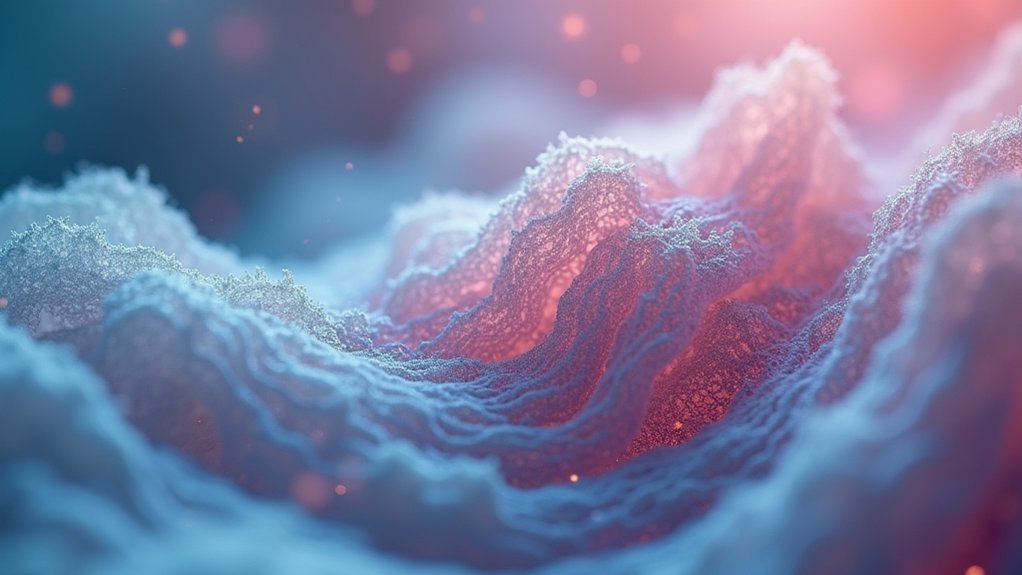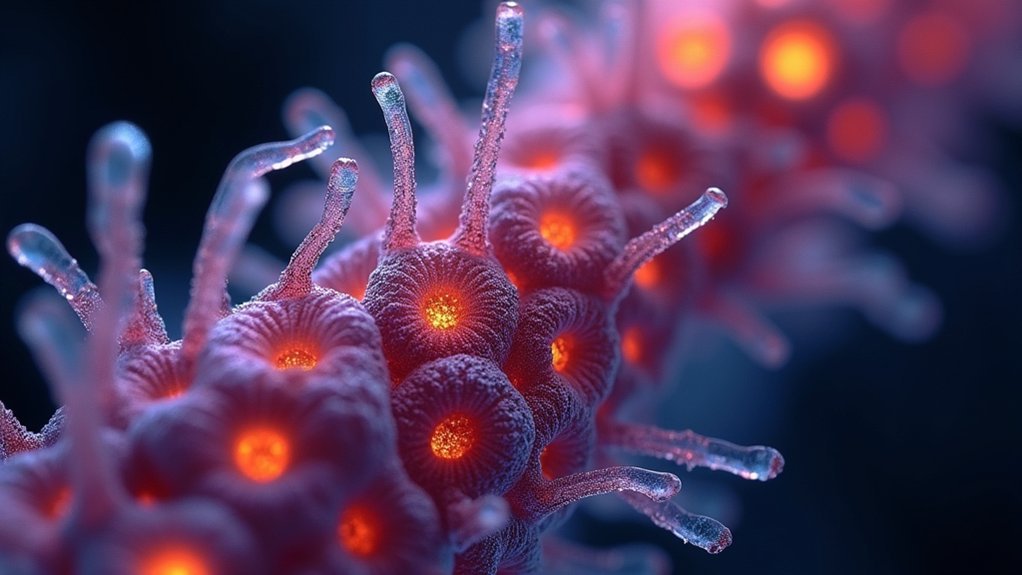The 7 best image noise filters for scientific photography include Gaussian blur for overall smoothing, median filtering for preserving edges, wavelet-based reduction for cellular imaging, non-local means for high-resolution detail retention, anisotropic diffusion for edge preservation, Richardson-Lucy deconvolution for optical clarity, and deep learning approaches for automated processing. You’ll need to balance noise reduction with maintaining critical scientific details. Each technique offers unique advantages for specific imaging scenarios and noise types.
Gaussian Blur Filter: Preserving Scientific Detail

While many noise reduction techniques sacrifice important details, the Gaussian blur filter stands out as an essential tool for scientific photographers who need to balance noise reduction with data preservation. It works by averaging pixel values within a specified radius, effectively smoothing out high-frequency noise while maintaining the integrity of low-frequency information in your images.
When applying Gaussian blur to scientific photography, you’ll need to carefully select the kernel size. Larger kernels provide greater noise reduction but risk blurring vital details necessary for accurate analysis.
The filter’s computational efficiency makes it accessible through most image processing software, allowing you to quickly process multiple images. Remember that moderation is key—excessive blurring can compromise the very scientific data you’re trying to capture and analyze.
Median Filtering For Microscopy Precision
Three significant factors make median filtering an indispensable tool for microscopy applications. First, unlike linear filters, it preserves vital edge details while effectively reducing noise—essential when examining cellular structures.
Median filtering stands out in microscopy by preserving critical edge details while eliminating noise—a crucial advantage for cellular imaging.
Second, it excels at eliminating salt-and-pepper noise that often plagues microscopy images without blurring important specimen details.
When processing your RAW files from microscope cameras, you’ll find median filtering particularly valuable for enhancing visibility of fine structures. The kernel size you select directly impacts your results; larger kernels remove more noise but might sacrifice detail.
For maximum noise reduction, choose your kernel size carefully based on your specimen’s features and the type of noise present. This balance guarantees your quantitative analyses remain accurate while providing the clearest possible visualization of microscopic structures.
Wavelet-Based Noise Reduction For Cell Imaging

Unlike traditional filtering methods, wavelet-based noise reduction represents a breakthrough for cell imaging applications where preserving structural integrity is essential. This technique decomposes your images into multiple frequency components, allowing you to target and remove Gaussian noise while maintaining vital cellular details.
You’ll find this approach particularly valuable as it lets you selectively process noise at different scales. By fine-tuning wavelet coefficients, you can appreciably improve signal-to-noise ratio without sacrificing spatial resolution—a critical balance in cellular studies.
The real advantage lies in how wavelet-based noise reduction handles the complex structures in cell images. When you apply these filters to microscopy data, you’ll achieve enhanced clarity and contrast, making subtle cellular structures and dynamics more visible for accurate analysis and interpretation.
Non-Local Means Algorithm For High-Resolution Specimens
The Non-Local Means algorithm stands out as a powerful noise reduction tool for your high-resolution specimen photography, preserving critical fine details while effectively eliminating unwanted artifacts.
You’ll appreciate how NLM compares pixels across the entire image based on similarity rather than proximity, maintaining sharpness in microscopy and astrophotography applications where conventional filters might blur important features.
Whether you’re using open-source platforms like ImageJ or commercial options such as Adobe Photoshop and Topaz DeNoise AI, NLM implementations are widely available despite their computational demands.
Key NLM Algorithm Benefits
When examining noise reduction options for high-resolution scientific specimens, Non-Local Means (NLM) stands out as a revolutionary approach that preserves critical details other algorithms might blur.
Unlike conventional noise reduction tools that process only adjacent pixels, NLM evaluates similar patterns across the entire image.
You’ll find NLM particularly valuable when you need to reduce the noise while maintaining complex textures in biological specimens. Its patch-based approach preserves fine structures that are essential for accurate analysis.
While more computationally demanding than traditional filters, NLM delivers superior signal-to-noise ratio enhancement without sacrificing detail integrity.
Before turning to AI noise reduction solutions, consider that NLM’s adaptive selection of relevant pixels often outperforms local approaches in maintaining the scientific validity of your specimen images.
Preserving Fine Specimen Details
Scientific researchers face a critical challenge when processing high-resolution specimen images: preserving essential microstructures while effectively eliminating noise. The Non-Local Means algorithm excels here by comparing all pixels across the entire image rather than just neighboring ones.
You’ll find NLM particularly valuable when examining intricate specimens where traditional filters blur critical features. By computing weighted averages based on neighborhood similarities, NLM can preserve fine details while delivering superior noise reduction.
| Specimen Type | Detail Preservation | Processing Requirements |
|---|---|---|
| Cellular | Excellent | High computational resources |
| Crystalline | Very good | Moderate resources |
| Tissue | Outstanding | Adjustable parameters |
While implementing NLM demands more computational resources than conventional methods, the results justify the investment—especially when your research depends on accurately visualizing microscopic structures without sacrificing clarity.
Implementation Across Platforms
Despite its computational demands, the Non-Local Means algorithm has been integrated into numerous scientific image processing platforms, making it accessible to researchers across disciplines.
You’ll find robust NLM implementations in ImageJ and MATLAB, where customizable parameters allow fine-tuning for specific specimen types and noise profiles.
Commercial photo editing solutions like Topaz Denoise AI have incorporated NLM principles, offering intuitive interfaces that simplify advanced noise reduction for scientific photographers.
These tools provide slider-based controls that adjust the algorithm’s strength while maintaining critical specimen details.
When working with high-resolution images containing subtle textures, you’ll appreciate how modern platforms optimize the algorithm’s performance through GPU acceleration and multi-threading, greatly reducing processing time while preserving the superior edge retention that makes NLM indispensable for scientific imaging.
Anisotropic Diffusion: Edge-Preserving Denoising
Among the most sophisticated noise reduction techniques available to scientific photographers, anisotropic diffusion stands out for its remarkable ability to preserve essential edge details while effectively eliminating unwanted noise.
This edge-preserving denoising method operates through a controlled diffusion process that adapts to image content.
When you’re working with significant scientific imagery, anisotropic diffusion offers several advantages:
- Selectively smooths regions based on gradient intensity, preserving vital structures
- Works iteratively through partial differential equations for precise noise control
- Excels at reducing Gaussian noise in biological and medical imaging applications
- Integrates seamlessly with popular platforms like MATLAB and OpenCV
You’ll find this technique particularly valuable when detail retention matters in your scientific photography workflow.
Richardson-Lucy Deconvolution For Optical Clarity

The Richardson-Lucy algorithm fundamentally works by iteratively estimating the original image through maximizing the likelihood that your blurred observation matches a statistical model of the imaging process.
You’ll need to accurately determine the point spread function of your optical system before implementation, either through calibration or theoretical modeling.
For best results, you should carefully balance the number of iterations—too few won’t sufficiently clarify your image while too many will amplify noise in your scientific photographs.
Algorithm Fundamentals
Richardson-Lucy deconvolution serves as a cornerstone technique in scientific image processing when optical clarity becomes paramount. This iterative reduction algorithm works by mathematically modeling the relationship between your blurred image and the original scene through a point spread function (PSF).
When you implement Richardson-Lucy deconvolution, you’ll:
- Start with a blurred image and known PSF of your optical system
- Iteratively refine your estimate of the original image through statistical calculations
- Improve the quality of fine details with each successful iteration
- Monitor the signal-to-noise ratio to determine the ideal stopping point
The computational intensity increases with higher resolution images, requiring careful parameter tuning.
Despite these challenges, the algorithm’s ability to recover previously obscured details makes it invaluable for scientific photography applications.
Practical Implementation Considerations
Successfully implementing deconvolution techniques requires careful attention to several practical considerations that can dramatically impact your results. When applying Richardson-Lucy deconvolution for noise removal, you’ll need accurate PSF measurements—either experimentally determined or analytically derived—to achieve ideal clarity.
| Implementation Factor | Challenge | Solution |
|---|---|---|
| PSF Accuracy | Incorrect blur estimation | Calibrate with point source |
| Iteration Count | Under/over processing | Monitor convergence metrics |
| Computational Load | Processing time | Use GPU acceleration |
| Noise Amplification | Detail vs. artifact balance | Apply pre-filtering |
| Software Selection | Learning curve | Choose intuitive tools |
Most modern editing options include Richardson-Lucy algorithms, but processing times vary considerably. For high-resolution scientific imagery, verify your tools work with your hardware capabilities, as deconvolution can be computationally intensive, especially with complex noise profiles.
Deep Learning Neural Networks For Automated Noise Removal
In recent years, deep learning neural networks have revolutionized image noise reduction, offering unprecedented precision and efficiency for scientific photography.
You’ll find these powerful tools particularly valuable when working with challenging imaging conditions common in scientific applications.
Deep learning approaches to automated noise removal provide several advantages:
- Adaptive processing – Networks like CNNs can identify and reduce various noise types (Gaussian, Poisson) while preserving critical image details.
- Superior performance – Models such as DnCNN and U-Net deliver exceptional results in low-light and high-ISO situations.
- Pattern recognition – Training on extensive image datasets enables these networks to distinguish between noise and important features.
- Workflow efficiency – Automated noise reduction processes deliver consistent, reliable results while greatly accelerating your scientific imaging workflow.
Frequently Asked Questions
What Is the Best Filter to Remove Noise?
For removing noise, you’ll get the best results with Topaz DeNoise AI. It’s powerful AI effectively reduces noise while preserving detail. If you prefer alternatives, try DxO PureRAW 2 or Adobe Lightroom’s AI Denoise.
What Is the Best Noise Reduction Software for Photography?
Topaz DeNoise AI is your best choice for photography noise reduction. It’s widely considered superior for preserving image detail while removing digital noise, especially in low-light shots, though it’ll cost you $79.99.
How Do I Reduce the Noise of a Picture on My Camera?
You can reduce noise by lowering your ISO setting, using your camera’s built-in noise reduction feature, shooting in RAW format, using longer exposures when possible, and applying noise reduction software during post-processing.
How to Reduce Noise in Image Processing?
You can reduce noise in image processing by applying median or Gaussian filters, using deconvolution techniques, implementing spatial or frequency domain filtering, or utilizing AI-powered software like Topaz DeNoise for better results.
In Summary
You’ve now got an extensive toolkit to tackle noise in your scientific images. Whether you’re working with microscopy specimens or high-resolution cell imaging, you’ll find the right solution among these seven filters. Remember, your choice depends on your specific requirements—some preserve fine details, while others excel at removing particular noise patterns. Test different approaches to discover which works best for your research needs.





Leave a Reply